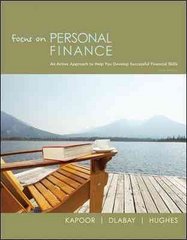Question
47.______How many intrinsic values can a stock have? a. one b. as many as it has shares outstanding. c. as many as it has shares
47.______How many intrinsic values can a stock have?
a. one
b. as many as it has shares outstanding.
c. as many as it has shares issued.
d. as many as it has shares authorized.
e. as many as it has people trying to determine that intrinsic value.
48._____You evaluated the stock of Apple (AAPL) on 1/17/20 and determine that its intrinsic value is $335. AAPL closed at $318.73 on 1/17/20 and traded in a range of $315.00 to $318.74. On 1/17/20, you should have
a. bought the stock.
b. sold the stock if you owned it.
c. shorted the stock if you didnt own it and were favorably, or at least not adversely, disposed toward shorting.
d. all of the above.
e. more than one, but not all of the above.
49._____At least theoretically, the risk embedded in your financial and economic forecasts in your analysis of stock should be embedded in the
a. discount rate you apply to future cash flows when valuing a stock.
b. discount rate you apply to the future net income of the issuer of the stock.
c. discount rate you apply to the historic cash flows when valuing a stock.
d. discount rate you apply to the historic net income of the issuer of the stock.
e. none of the above.
f. more than one, but not all, of the above.
50._____If you believe in the strongest forms of the efficient market theory (BEST answer!)
a. you have to be more careful when doing your analysis of a stock.
b. you have to be less careful when doing your analysis of a stock.
c. why bother to do any analysis on a stock?
d. you should never buy stocks.
e. none of the above.
51.______The great irony of the efficient market thesis is that
a. its only true to the extent that everyone believes in it.
b. its only true to the extent that no one believes in it.
c. it can only be true if not everyone believes it.
d. efficiency results in losses of jobs.
e. efficiency does not always result in profitability.
52._____Key economic factors to consider when analyzing an individual stock include
a. sales growth.
b. inflation.
c. economic growth.
d. consumer spending.
e. all of the above.
f. more than one, but not all, of the above.
53.______According to your instructor, the major financial statements used in financial analysis are the
a. cash flow statement.
b. income statement.
c. balance sheet.
d. all of the above.
e. more than one, but not all, of the above.
54.______Ratio analysis
a. is the be-all and end-all, the sine qua non, of financial analysis.
b. provides instant answers.
c. provides clear guidance in making buy or sell decisions.
d. guides the analyst to fruitful areas of further inquiry.
e. is completely useless.
Use the following numbers for Sweat Equity, Inc. (BO) for questions 55-58:
Profit Margin (NI/Sales) 4%
Asset turnover (Sales/Total assets) 8 times
Total liabilities $0
55.______What is BOs return on equity (ROE)? (BEST answer!)
a. cannot determine from the information given
b. probably can determine from the information given but I have no idea
c. 32%
d. 49%
e. something greater than 50%
56.______BO could improve its return on equity by
a. improving profit margin
b. improving asset turnover
c. applying some financial leverage
d. all of the above
e. some of the above
57.______BO could hurt (i.e., reduce) its return on equity by
a. improving profit margin
b. improving asset turnover
c. applying some financial leverage
d. all of the above
e. some of the above
58.______By applying some financial leverage in questions 56 and 57, your insightful instructor means
a. going into the lever business
b. buying Lever Brothers
c. repaying some debt
d. borrowing some money to finance operations
e. selling more common stock
Step by Step Solution
There are 3 Steps involved in it
Step: 1

Get Instant Access to Expert-Tailored Solutions
See step-by-step solutions with expert insights and AI powered tools for academic success
Step: 2

Step: 3

Ace Your Homework with AI
Get the answers you need in no time with our AI-driven, step-by-step assistance
Get Started


